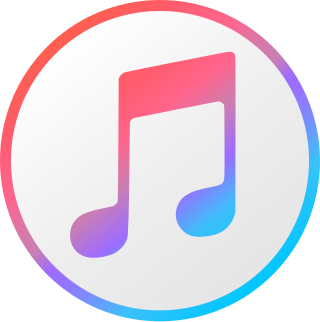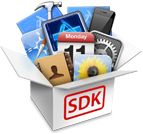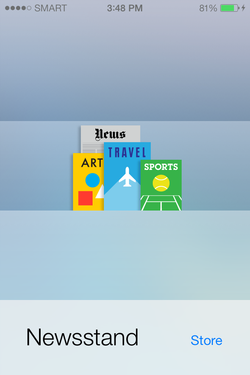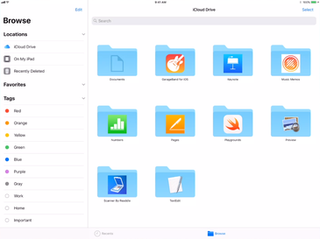Related Research Articles

iTunes is a discontinued media player, media library, and mobile device management utility developed by Apple. It was used to purchase, play, download and organize digital multimedia on personal computers running the macOS and Windows operating systems, and can be used to rip songs from CDs as well as playing content from dynamic, smart playlists. It includes options for sound optimization and wirelessly sharing iTunes libraries.

Xcode is Apple's integrated development environment (IDE) for macOS, used to develop software for macOS, iOS, iPadOS, watchOS, tvOS, and visionOS. It was initially released in late 2003; the latest stable release is version 15, released on September 18, 2023, and is available free of charge via the Mac App Store and the Apple Developer website. Registered developers can also download preview releases and prior versions of the suite through the Apple Developer website. Xcode includes command-line tools that enable UNIX-style development via the Terminal app in macOS. They can also be downloaded and installed without the GUI.
In the macOS, iOS, NeXTSTEP, and GNUstep programming frameworks, property list files are files that store serialized objects. Property list files use the filename extension .plist, and thus are often referred to as p-list files.
In NeXTSTEP, OPENSTEP, and their lineal descendants macOS, iOS, iPadOS, tvOS, and watchOS, and in GNUstep, a bundle is a file directory with a defined structure and file extension, allowing related files to be grouped together as a conceptually single item.
The Apple Developer Tools are a suite of software tools from Apple to aid in making software dynamic titles for the macOS and iOS platforms. The developer tools were formerly included on macOS install media, but are now exclusively distributed over the Internet. As of MacOS 14.6.1, Xcode is available as a free download from the Mac App Store.
webarchive is a Web archive file format available on macOS and Windows for saving and reviewing complete web pages using the Safari web browser. The webarchive format differs from a standalone HTML file because it also saves linked files such as images, CSS, and JavaScript. The webarchive format is a concatenation of source files with filenames saved in the binary plist format using NSKeyedArchiver. Support for webarchive documents was added in Safari 4 Beta on Windows and is included in subsequent versions. Safari in iOS 13 has support for web archive files. Previously there was a third party iOS app called Web Archive Viewer that provided this functionality.

iOS is a mobile operating system developed by Apple exclusively for its smartphones. It was unveiled in January 2007 for the first-generation iPhone, launched in June 2007.

The iOS SDK, formerly the iPhone SDK, is a software development kit (SDK) developed by Apple Inc. The kit allows for the development of mobile apps on Apple's iOS and iPadOS operating systems.
SpringBoard is the standard application that manages the iPhone's home screen. Other tasks include starting WindowServer, launching and bootstrapping applications, and setting some of the device's settings on startup.

EPUB is an e-book file format that uses the ".epub" file extension. The term is short for electronic publication and is sometimes stylized as ePUB. EPUB is supported by many e-readers, and compatible software is available for most smartphones, tablets, and computers. EPUB is a technical standard published by the International Digital Publishing Forum (IDPF). It became an official standard of the IDPF in September 2007, superseding the older Open eBook (OEB) standard.

AppleDisk Image is a disk image format commonly used by the macOS operating system. When opened, an Apple Disk Image is mounted as a volume within the Finder.
Sideloading describes the process of transferring files between two local devices, in particular between a personal computer and a mobile device such as a mobile phone, smartphone, PDA, tablet, portable media player or e-reader.

Apple Newsstand was a built-in iOS application for the iPad, iPhone and iPod touch. It was dedicated to downloading and displaying digital versions of newspapers and magazines. It was replaced by Apple News in iOS 9.
TestFlight is an online service for over-the-air installation and testing of mobile applications, currently owned by Apple Inc. and only offered to developers within the iOS Developer Program. Developers sign up with the service to distribute applications to internal or external beta testers, who can subsequently send feedback about the application to developers. The TestFlight SDK additionally allows developers to receive remote logs, crash reports and tester feedback.
IPSW is a file format used to install iOS, iPadOS, tvOS, HomePod, watchOS, and most recently, macOS firmware for devices equipped with Apple silicon. All Apple devices share the same IPSW file format for iOS firmware and their derivatives, allowing users to flash their devices through Finder or iTunes on macOS or Windows, respectively. Users can flash Apple silicon Macs through Apple Configurator 2.
XcodeGhost are modified versions of Apple's Xcode development environment that are considered malware. The software first gained widespread attention in September 2015, when a number of apps originating from China harbored the malicious code. It was thought to be the "first large-scale attack on Apple's App Store", according to the BBC. The problems were first identified by researchers at Alibaba, a leading e-commerce firm in China. Over 4000 apps are infected, according to FireEye, far more than the 25 initially acknowledged by Apple, including apps from authors outside China.

macOS Sierra is the thirteenth major release of macOS, Apple Inc.'s desktop and server operating system for Macintosh computers. The name "macOS" stems from the intention to unify the operating system's name with that of iOS, watchOS and tvOS. Sierra is named after the Sierra Nevada mountain range in California and Nevada. Specifically, Mount Whitney is the location for macOS Sierra's default wallpaper. Its major new features concern Continuity, iCloud, and windowing, as well as support for Apple Pay and Siri.

Files is a file management app developed by Apple Inc. for devices that run iOS 11 and later or iPadOS. Discovered as a placeholder title in the App Store just prior to the company's 2017 Worldwide Developers Conference, the app was officially announced at the conference shortly thereafter. Files allows users to browse local files stored within apps, as well as files stored in cloud storage services including iCloud, Dropbox, OneDrive, and Google Drive. It allows for the saving, opening and organization of files, including placement into structured folders and sub-folders. iPadOS and recent versions of iOS are able to drag-and-drop files between Files and other apps, while iOS versions before iOS 15 are limited to drag-and-drop inside Files itself. Further organization can be done through the use of color-coded or custom-named tags, and a persistent search bar allows for finding files inside folders, though not inside other apps. A list view enables different sorting options. The app offers the exclusive playback of high-quality FLAC audio files, and also offers support for viewing text files, images, "Music Memos", and Zip archives, as well as limited support for video.
References
- ↑ "How to open an IPA file on Windows". Reincubate. Retrieved 2019-04-08.
- ↑ "itunes – How does iOS app DRM work, exactly?". Ask Different. 2012.
- ↑ Clover, Juli (2017-09-12), Apple Releases iTunes 12.7 With Major Changes, Including No Built-In App Store, MacRumors , retrieved 2024-03-08
- ↑ "Reverse Engineering iOS Applications" (PDF). ARXAN. 2014. Archived from the original (PDF) on 2017-12-22. Retrieved 2019-04-08.
- ↑ "unzip with lzfse support". sskaje. 23 August 2017. Archived from the original on 29 July 2021. Retrieved 21 March 2023.
- ↑ "Pulling apart an iOS App". Raz. 29 December 2017. Archived from the original on 14 July 2020. Retrieved 4 March 2020.
- ↑ "AppSync Unified :: Karen's Repo". cydia.akemi.ai.